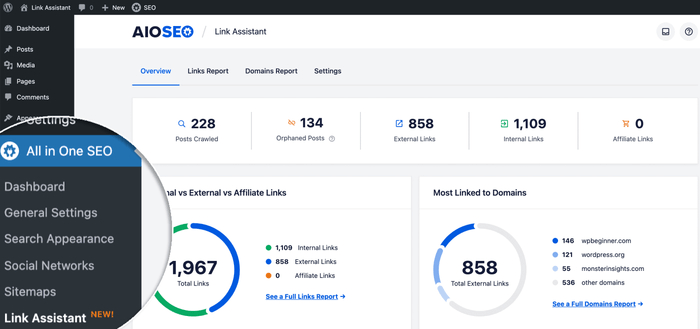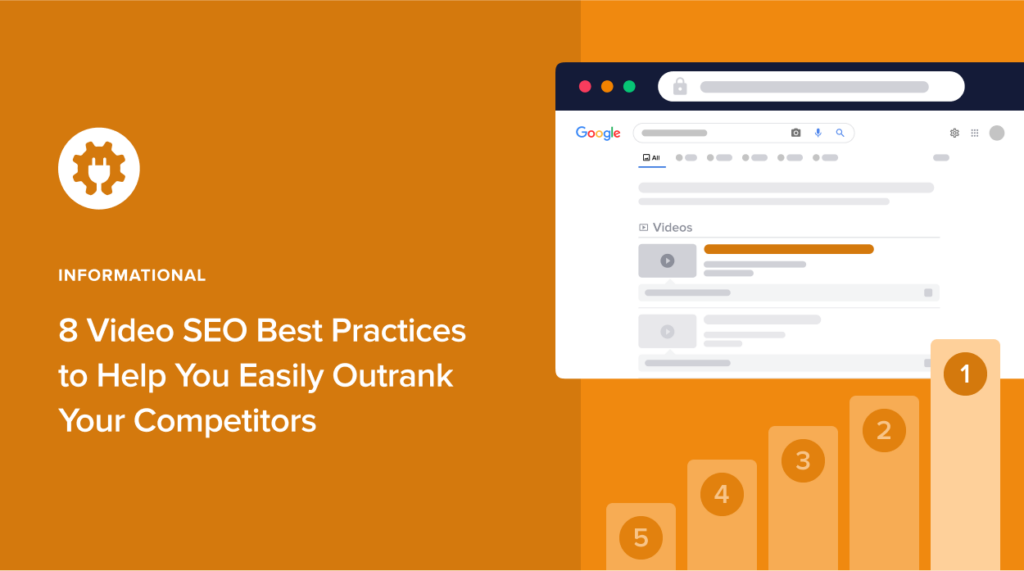Want to nail your video SEO?
Search engine optimization (SEO) is a crucial element of any marketing strategy. Video marketing is no different.
To get your videos to rank, drive traffic, and generate leads, you must know the video SEO best practices to implement in your video content strategy.
What is Video SEO (and Why is it Important)?
Video SEO refers to the practice of optimizing your videos to rank on search engine results pages (SERPs) for relevant keyword searches. Doing so results in maximum visibility and a boost in traffic to your video content. Two of the most important elements of video optimization are:
- Getting your videos indexed: Search engines aren’t (yet) able to understand all the relevant information in videos embedded on a website. Because of this, you have to do a bit of extra groundwork to get your video content indexed.
- Ranking your videos higher on SERPs: Getting your videos to rank results in more traffic to your videos and ultimately leads to you growing your audience and business.
We’ll look at how to achieve both in the section below.
Why is Video SEO Important?
Video is fast becoming the most preferred content format online. With research showing that over 1 billion hours of video are watched on YouTube alone, ignoring video means missing out on a large segment of the market. The same research shows that video production has dramatically increased over the past few years to 500 minutes of video content uploaded to YouTube every minute.

Of course, to ensure that your video marketing succeeds, you must invest in creating high-quality content. Thankfully, with the advancements in technology, doing this isn’t hard or expensive. You can even create high-quality videos using a smartphone and good video editing software.
That’s why you, as a small business, have no excuse for not investing in this much-loved content format as you map out your digital marketing strategy.
Rank Your Videos with these 8 Video SEO Tips
Video marketing is fast becoming one of the most effective ways of reaching an engaged audience. One reason for this is people prefer interactive content over its static counterpart.
That’s why you must invest in developing and deploying an effective video SEO strategy that will see you ranking top of the SERPs, especially for video search. Here are a few tips to help you do just that:
1. Choose Your Video Hosting Platform Wisely
One of the first steps to ensuring that your videos rank well is to host them on the right platform. To choose the right platform, you must determine what the purpose of your video is.
Is it to establish yourself as a thought leader?
Or is it to drive traffic to your site?
If thought leadership is your ultimate goal, then platforms like YouTube and Vimeo will serve you perfectly. However, hosting your videos on such platforms means all your traffic goes there and not to your website. That’s why, if traffic generation is your goal, then using video platforms like Vimeo, Vidyard, Wistia, and others, is advised. They enable you to host videos on your own website. As a result, when people discover your videos on SERPs, all the traffic goes directly to your website, not a third-party platform.
Hosting videos on your own website also enhances the user experience as people won’t have to search for your website after watching your video.
2. Make Your Videos Easy to Find and Index
Once you’ve hosted your video on the right platform, you need to make it easy for search engines to find and index your videos. The best way to do this is to create a dedicated page on your website for each video. When you embed your video on that page, include your video in an HTML tag so search engines can easily identify the video on your web page. Here are some examples of tags you can use:
<video>, <embed>, <iframe>, or <object> Another tip is to try and ensure the video and its subject are the most prominent subjects on the page. Also, make sure the page isn’t blocked in your robots.txt and that it has a no-index robots meta tag.
3. Craft a Compelling Video Title and Description
As with your blog posts, your title plays a huge role in helping your video rank.

For one, a keyword-optimized title makes it easy for search engines to understand what your video is about. It also helps convince users to click and watch your video if:
- Your keyword research is on point
- Your title promises to answer a question or solve a problem
Besides your video title, another element you need to craft carefully is your video description. This is a summary of what users can expect from watching. Write your description in such a way that it’s engaging and convinces searchers to click on your link in search results. Your title, description, and other metadata elements (like the meta description) help boost your clickthrough rates, thereby helping boost your SEO.
4. Publish an Optimized Video Transcript
To increase the chances of your video becoming more visible in search, you need to publish an optimized video transcript on the page your video is embedded.
One of the biggest advantages of a video transcript is that it acts like page copy. This gives you many more opportunities to optimize for visibility. Just like you would a normal text-first page, you can optimize your video transcript by:
- Including your focus keyword and its variants/synonyms
- Matching your copy with user intent
- Include keyword-optimized header tags if and when necessary
A video transcript makes your page more accessible. More importantly, Google can’t crawl video content (yet). A video transcript gives you a better chance of having your video indexed as it shows search engines what your video is about.
5. Boost Your Video SEO with a Video Sitemap
A sitemap is a page that provides information about the pages and files on your website. When designing a video marketing strategy, you should also consider adding a video sitemap to your site.
In this regard, a video sitemap provides additional information about the videos hosted on your website. It’s an excellent way to help search engines find and understand your video content, especially since search engines can’t crawl video content.
Thankfully, creating a video sitemap is super easy with a powerful tool like AIOSEO. To get started, head over to your AIOSEO dashboard and select Sitemaps. Select the Video Sitemap option and click on Activate Video Sitemap.
Once the video sitemap is enabled, you can create and configure your video sitemaps without touching a single line of code. Here’s a detailed guide on how to do so.
After creating your sitemap, submit it to Google as you would a normal sitemap. With our IndexNow feature, your sitemap can instantly be indexed with Bing and other search engines that support the IndexNow protocol.
6. Design Attractive, Eye-catching Video Thumbnails
While thumbnails don’t impact SEO directly, they have an indirect influence on how search engines rank your videos. Attractive thumbnails help drive up your clickthrough rates, signalling to search engines that searchers find your content to be valuable.

On the other hand, poorly designed thumbnails lead to fewer clicks on your videos on SERPs, resulting in poor search rankings.
A few tips for designing eye-catching custom thumbnails include:
- Use high-quality thumbnail images
- Draw attention to faces, emotions, and results
- Avoid clickbaity thumbnails
- Include your branding to enhance brand awareness
- Add a subtitle to further explain what your video is about
A well-designed video thumbnail will stop searchers in their tracks and draw them to your video. It’s critical to improving your conversion rates and boosting your video SEO.
7. Build Links to Your Video Pages
Links are the building blocks of the internet.
That’s why you must have a link building strategy designed to boost your video content marketing. This strategy must include:
Internal Links
One of the most important types of links you can build to boost the page your video is on are internal links. Internal links refer to links built between pages on a website. Find blog posts on your website that contain information that’s relevant to your page and link to them.
Though this may sound like a laborious task, it can be done effortlessly with AIOSEO’s Link Assistant.

With Link Assistant, you can automatically find relevant pages and add them to any page on your website. This makes it easy to build relevant internal links to your video page.
Outbound Links
Outbound links are links from a page or post on your website to a page on another website. This helps build the authority of the page. When building outbound links, make sure to link to trusted authority sites. Also, ensure the content you’re linking to is relevant to your video and adds more value to it.
Backlinks
Backlinks (also called inbound links) are regarded as the most important type of links you can build on your website. But more than that, they’re a vote of confidence signalling that other websites value your video content. As a result, Google uses backlinks as one of its most significant ranking factors. A few ways to build backlinks to your videos include:
- Guest post and link to your video content
- Run an outreach campaign
- Find and fix broken links
- Spy on your competitors and reach out to publishers linking to them
The more backlinks you build to your video content, the higher they rank in search.
8. Have a Video Promotion Strategy in Place
One of the most important benefits of SEO is that it drives traffic to your digital assets. The result of that increased traffic is a boost in SEO.
That’s why one element of video SEO you must include in your strategy is video content promotion.
Content promotion is the practice of strategically using other channels, besides Google search (and other search engines), to get your content in front of your target audience. This helps drive relevant traffic to your site. Some content promotion tips for promoting your videos include:
- Add important videos to your email signature
- Share your videos on social media for organic traffic
- Used paid channels like PPC and paid social media
- Use tools like RafflePress to run contests to drive traffic and engagement
No matter how amazing your video is, to get it viewed by the right people requires that you promote it aggressively. This is where most small businesses fall short. They create exceptional content and neglect to market it.
After creating your videos and applying video SEO best practices, give your campaign more mileage by promoting your videos.
Video SEO: Powering Your Digital Marketing Strategy
Ranking your videos in search has become a critical element of a robust digital marketing strategy. With video being the most consumed content type on the internet, tapping into this format is a no-brainer.
Using the nine video SEO tips outlined above, getting your videos to rank won’t be as difficult. That’s especially with a powerful SEO plugin like AIOSEO. AIOSEO is a toolkit designed to help you implement SEO best practices on your website and content. It also helps optimize your social shares for improved engagement, helping drive more traffic to your videos.
If you’re not using AIOSEO yet, what are you waiting for?
Download AIOSEO today and improve your chances of ranking your content on SERPs.
Disclosure: Our content is reader-supported. This means if you click on some of our links, then we may earn a commission. We only recommend products that we believe will add value to our readers.

